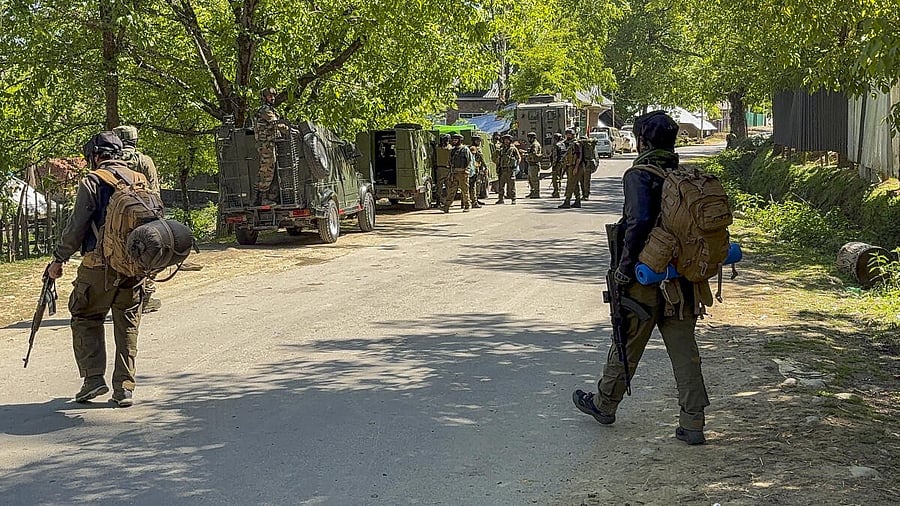
Security personnel conduct a cordon and search operation as a security measure after the recent Pahalgam terror attack, in Anantnag, Jammu and Kashmir.
Credit: PTI Photo
Srinagar: The battle-hardened terrorists — mostly Pakistani nationals — who killed 26 civilians near Pahalgam on April 22 continue to evade capture despite an intensive manhunt launched by the Army, Jammu and Kashmir police, and central agencies.
According to multiple security sources, the group remains holed up in the dense, mountainous forests of south Kashmir, using advanced tactics and jungle warfare skills to stay a step ahead of the forces.
The terrorists, reportedly armed with advanced rifles, encrypted communication gadgets, and survival provisions, have managed to slip through cordons on multiple occasions in recent days, frustrating security agencies and revealing the high degree of training and coordination among the group.
“These are not your average infiltrators. They are trained in jungle warfare, capable of surviving in the forest for weeks without detection, and are constantly on the move using offline navigation tools,” said a senior police officer involved in counterinsurgency operations. “They carry dry rations, avoid any digital footprint, and are well-versed with the terrain.”
The group narrowly escaped at least three near-encounters in the past week, sources said. In each case, troops launched cordon-and-search operations based on actionable inputs, but the terrorists had already moved before forces could close in.
The National Investigation Agency (NIA), which has taken over the probe from J&K Police, has reportedly found that the group was present in Baisaran Valley — a tourist hotspot above Pahalgam — at least 48 hours before the April 22 massacre. They seem to have surveyed the area thoroughly before striking.
“Over Ground Workers (OGWs), or terrorist sympathisers, interrogated after the attack have revealed that three other locations in Pahalgam, - the Aru and Betaab valleys and amusement park – were also recced for terror attack. But all of them were heavily guarded and so the terrorists picked Baisaran,” sources said.
The security establishment believes this group may be the same as the one involved in a series of deadly attacks in the Poonch-Rajouri belt, and later across Kathua, Udhampur, Doda, and Kishtwar — a pattern that has not only revived militancy in the Pir Panjal region but brought fresh terror into parts of mainland Jammu.
“Pakistani handlers have clearly changed tactics,” the police officer said. “Instead of launching terrorists into the urban heartland, they’ve now shifted them to jungle belts where detection is far more difficult. These terrorists have adapted to the harsh forest environment, surviving even sub-zero temperatures in winter.”
Another counterterrorism official said the terrorists are using Chinese-made communication devices that function offline, such as Ultraset phones. “We’ve recovered these in past encounters. In some cases, they’re using preloaded offline maps and carefully avoiding areas with surveillance coverage,” he said.
The security grid remains on high alert as the search continues across sprawling forest belts from Anantnag to Kulgam. While officials are confident the group will eventually be neutralised, they admit it may take time — and a change in tactics — to catch what they describe as “professional, highly trained terrorists with a long-term agenda.”
“We are dealing with a new threat. These are no longer hit-and-run attackers. They are here to stay, and we will have to change the way we operate,” the officer added.